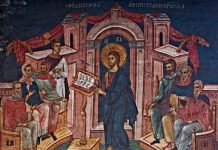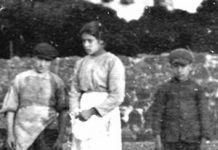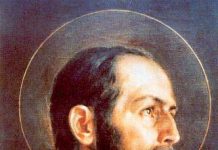Thomas Merton’s poem “Pass through My Will” takes the reader on a deeply mystical journey through layers upon layers of spiritual significance. At the same time, it captures the simplicity of a folk song and the heart-felt purity of a romantic ballad. The musical accompaniment by John Michael Talbot broadens its beauty even further and makes it sing out from the soul. I have endeavored to write down some of my own reflections on it, and hope that your own individual musings may add to them when you read the poem included at the end.
The mood of the poem is set by the opening invitation, “Come, my love…” We are introduced to a relationship with our Creator that is the pinnacle of intimacy and desire. The words recall the prayer “Veni Sancti Spiritus”, asking the Holy Spirit to visit us with his purifying fire and enkindle us with the flame of love. The following request to “pass through my will as through a window” courts a total giving by laying down one’s own self for the light of the sun to penetrate, gently yet powerfully, so that lover and beloved may be transformed into one another.
This sacrifice of will highlights the subtle Marian undercurrent of the poem. At the visitation of the Angel Gabriel, the Virgin Mary chose to surrender her own will so that God could truly “penetrate” her with His light in a singularly astonishing may, causing the Word Made Flesh to enter into history when the Spirit overshadowed her. It also brings to mind the long-held Catholic tradition that birth of Christ, in addition to His conception, took place in a miraculous manner, as light passing through glass, thus enabling Our Lady to forego the pains of childbirth.
In the first verse, the poet compares himself to the grass “to be consumed by the rays of the sun.” This burns with a fiery longing for an encounter with a lover. Not just any lover…but the Seed of all Love, the Answer of all Longing. There is the heat and freshness of youthful eagerness “in the late summer’s morning”, running barefoot through a grassy meadow with reckless abandon. And yet it is not aggressive like a beast, but spontaneous like the flow of a river. It is natural in the Bosom of Nature. As the grass depends upon the light of the sun for its very existence, so we depend upon the light of the Son for ours.
The poem is particularly striking in its reclamation of sexuality as a sacred, life-giving, unifying expression of a greater spiritual love radiating from within. In Celtic tradition, it is said that the soul is not so much within the body as the body is within the soul, an aura of light that encompasses our beings. At the same time, our “clay homes” serve as instruments of making manifest the deeper movements of the heart. That is why marriage is such a highly honored sacrament in Christianity, and weddings so gloriously celebrated. The physical is only a small fragmentary glimpse of the spiritual unity which this poem celebrates. And yet even that fragment is worthy of honor within the bonds of a sacramental, life-long commitment.
Interestingly, Catholic tradition has had a multi-faceted understanding of “spiritual sexuality” as it were. While physical relations are certainly the norm in married life, there was also a deeper understanding that people are called to a variety of different walks in life, and virginal marriage was also an option, as in the case of St. Cecelia, who had taken a vow of perpetual chastity along with her spouse. Nevertheless, her relationship with her husband Valerian was nothing short of rivetingly romantic, as he was spiritually awakened the purity of her voice, and she would go on to sacrifice her life in order to attend his grave. Similarly, in religious and single vocations, the concept of spiritual union was just as intense and real as any romantic experiences could be. There is a universal romance to which every human being is called to: the Marriage of the Soul to its Source.
With this understanding, the poem calls for the coming of the Divine Lover, as “all through the night I lay longing, eagerly to wait for love’s union”. There is no shame in this, but rather a reveling in the anticipation as it was meant to be before perversion and misuse debased it. The Divine Bridegroom is being called upon by His bride the Church. The night can be seen both as the time before the coming of Christ, waiting for the coming of the Messiah. It can also be seen as our own present time, awaiting his second coming when love between God and His people will be “consummated in the light.” In a personal context, it can also be seen as every person’s own inner demons, their “dark night of the soul”, as so eloquently described by St. John of the Cross during his years of persecution and imprisonment. It is in the depths of doubt and despair that our yearning for the light becomes most keen. We yearn for it to cut through the veil of night like a piercing sword of the dawn.
And so we wait “as dawn’s flower awaits for the wedding with the sun.” This brings to mind the fact that flowers turn towards the light of the sun and open their petals to receive it. But in a deeper sense, it speaks of the essence of the dawn that cannot be seen, the stream of all being and reality brought to light by the sun. It also brings to mind the wedding feast at Cana, where Jesus performed his first miracle by turning the water jugs into the best wine at his mother’s request. Interestingly, the pagan world had long associated wine with fertility, and their gods of the grape vines commonly doubled as gods of the marriage bed. In this act of Christ, we not only see His honour of his mother (the woman whose body gave him life through God-given fertility) but also of marriage and procreation in general, as well as the celebration of life. Lastly, it calls to mind the experiences of the great saints, such as St. Catherine of Sienna, who experienced visions of a mystical marriage to Christ, and a ring encrusted with blood-jewels, like the blood-red wounds of the Bridegroom.
The poem goes on to explain that the light is in fact “stealing my heart as a secret.” Again, there is a beautiful level of intimacy and gentility here, for just as the Creation of the World was brought into being by a Word, so we can imagine a secret being whispered to us in a passing breeze the travels “under the moments, crossing time”, something so beautiful it takes our breaths away. It is the Great Secret for which we all seek, that knowing that catches us up in the celestial spiral dance of eternity. The line also brings to the fore the subtle vulnerability of love. When we open our hearts to another, we always risk having them broken. And yet that risk is the very ground-work of all that is worthy of experiencing and embracing. We want our hearts to be stolen away, for they were never meant to be for us alone, but for the Other. The homonym of “stealing” also comes to mind, in that the light is also “steeling” the heart, making it stronger for the trials to come.
The language of the poem begins to take a slightly darker turn. The light of the divine is also portrayed as a thing of great aloneness, perhaps even a cause for despair, for like the Rich Young Man, we are being asked to give all that we hold dear in exchange. We abandon our creature comforts and face ourselves as we truly are in order to face the One who gave us our very being on our own. We become “a vanishing form that leaves no shadows.” Like Moses, our faces have been bleached white by “I Am Who Am.” There is no hiding, no shielding, no shying away from the light. It is all-consuming and all-encompassing, stripping away all that is unnecessary, penetrating to the bare essence of our soul. We find ourselves “exposed naked, alone, between the heavens and the earth”, crossed between comfort and discomfort, twisted in both agony and ecstasy like St. Teresa of Avila being pierced by the angel’s dart.
Nakedness holds many symbolic meanings. One is naked before a physician seeking to cure the maladies of the body, appropriate as we encounter Yeshua, the Great Physician, who walked among men with His healing hand extended with mercy towards those in physical and spiritual need. One is naked before a lover in the act of union and procreation, but also naked in a spiritual sense in emotional bonding, which indicates a depth of truth and love that transcends the merely physical and enraptures the heart. Before the Great Lover, we find ourselves comfortable in our own flesh once more, just as we were in the innocence of Eden when the wind of the Spirit brushed against the branches…and we felt it.
But yet again, comfort contrasts with discomfort, for our stark nakedness before God also implies isolation This ultimate act of love in which we yearn to immerse ourselves in is also an embrace of pain and humiliation, of bitter wind against exposed flesh, of the wood of a tree so like the tree of Eden…the only thing strong enough to counteract it. And if we are to be Lover and Beloved, we must be prepared to suffer with Him on that cross, naked as He was naked, mocked and scorned and spat upon. It is agony. It is ecstasy. It is forsakenness. It is the eye of the storm of Love. Rejection and loneliness inevitably draw us closer to the fruit of Golgotha and the wine of the mystical wedding feast, “lifted high on the cross with the savior.”
Again, Our Lady comes to mind, standing beneath the wood of the cross like Eve, the mother of all humanity, had once stood before her tree of blessing and curse the set into motion such a story and brought forth such a savior. In this instant, Mary undergoes the pains of labor which may have passed her by in the stable, birthing the Universal Church and becoming a Mother for all of its members and of humanity as a whole, represented by the young John, holding her erect in her own agony. Pinioned to the cross, this naked exposure is also found in the Body of Christ exposed in the Eucharist, those physical elements lent to him by the body of his mother. Received within our own bodies, we truly enter into “love’s union” in the deepest of ways.
The next profound paradox we encounter is the “life-giving tomb, prepared through the night for dawn’s dying.” Again, there is the reference to the dawn, linked closely with the homonyms of “sun” and “Son”. In the aftermath of the consummation of love on the cross, having poured out his very essence for the beloved, Christ is laid to rest. His sleeping place is the tomb, which serves as a second womb from which He will be reborn and with Him “a child, New Jerusalem.” In essence, all of us will join him in that act of rising. The Old Covenant has passed over into the New, and the wine of redemption is about to be poured into new wine skins.
There is also the reference to the moon, which guides us through the night. This can be seen as yet another Marian allegory, as the moon is the ultimate “star of the sea”, commanding the tides of the ocean. The moon also commonly represents the female complement to the male sun. Also, Lady Moon reflects the glory of Lord Sun and leads us to the break of dawn, as the Virgin Mary directs us to her Son, and guides us across the Veil of Tears. Mythologically, stars are sometimes referred to as “tears of the moon”, which also can be seen as a reference to water and the sea. The moon can also be seen as the bride of Christ, representing all of us, the Church. This hearkens back to another mythology: how the Sun loved the Moon so dearly, that he died every night to allow her to draw breath.
But the sting of death never holds full sway. The light is coming; the darker the night is, the sooner it comes. Nature teaches us this is the cold embrace of winter, when the longest night of the solstice heralds the return of the sun. So it is with Christmas, a celebration of the light coming into the darkness. Perhaps it only now, at the cross and at the tomb, that we realize fully that the darkness could not know the light. Yet still the light could not be conquered. In the crux of defeat, victory is born. Like the darkness of Mary’s womb, the tomb prepares for “the rebirth of a child, New Jerusalem.” And so we welcome the light into our life, and shimmer like the rainbow of prisms cast through the stained-glass windows of our souls.
At the end of the poem, the paradox is brought full circle with the line: “I like the grass to be washed by the rains of the sun.” Once again this brings to mind a symbolic nakedness, necessary for bathing and cleansing in the waters of eternal life. It also brings to mind the rejuvenating freshness of a bath after having traveled on a long journey, the Royal Road of the Cross. But unlike the earlier reference to “consuming”, the use of “washing” also provides a gentler contrast that harkens back to our own gentle rebirth at the sacrament of Baptism.
As with all romances, the intensity has been mellowed (and also perhaps matured) with time, and yet it has also been rejuvenated by experiencing the cycle of life, death, and rebirth. We have been drained of our egoism and purified by the fires of Divine Love, transformed and reawakened as spiritual beings. But now, instead of the tension of young passions, we have found balance and equilibrium. Lover and beloved have been joined, and flow together in harmony like a stream of sanctifying grace, or matching footprints on the sands of time and eternity.
Come, my love,
Pass through my will
As through a window
Shine on my life
As on a meadow
I like the grass to be consumed
By the rays of the sun
On a late summer’s morning
Come, my love,
All through the night
I lay longing
Eagerly to wait
For love’s union
Like dawn’s flower awaits
For the wedding with the sun
Consummated in the light
Your light, my love,
Is stealing my heart
As a secret
I’m left
Like a vanishing form
That leaves no shadows
Exposed naked, alone
Between the heavens and the earth
Lifted high on the cross with the Savior
O life-giving tomb,
Prepared through the night
For dawn’s dying
Like a moon
Like the mansions of heaven
Await the rebirth of a child
New Jerusalem
So come to my life, Light of Heaven
Come, my love,
Pass through my will
As through a window
Shine on my life
As on a meadow
I like the grass to be washed
By the rays of the sun
On the late summer’s morning
Avellina Balestri (aka Rosaria Marie) is one of the founding members and the Editor-in-Chief of The Fellowship of the King, a Catholic literary magazine featuring the works of homeschool students, homeschool graduates, and beyond. She reads and writes extensively about the history and culture of the British Isles, taking a special interest in the legends of Robin Hood and the stories of the Catholic English Martyrs. She also sings, composes, and plays the penny whistle and bodhran drum, drawing inspiration from Celtic music artists such as Loreena McKennitt. She also spends her time watching and reviewing classic movies, networking with a host of zany international contacts, and last but certainly not least, striving to deepen her relationship with the Ultimate Love and Source of Creativity, and share that love and creativity with others.
Thomas Merton (1915-1968), mystic, author, and poet, was a Trappist monk of Gethsemani Abbey, in Kentucky.










